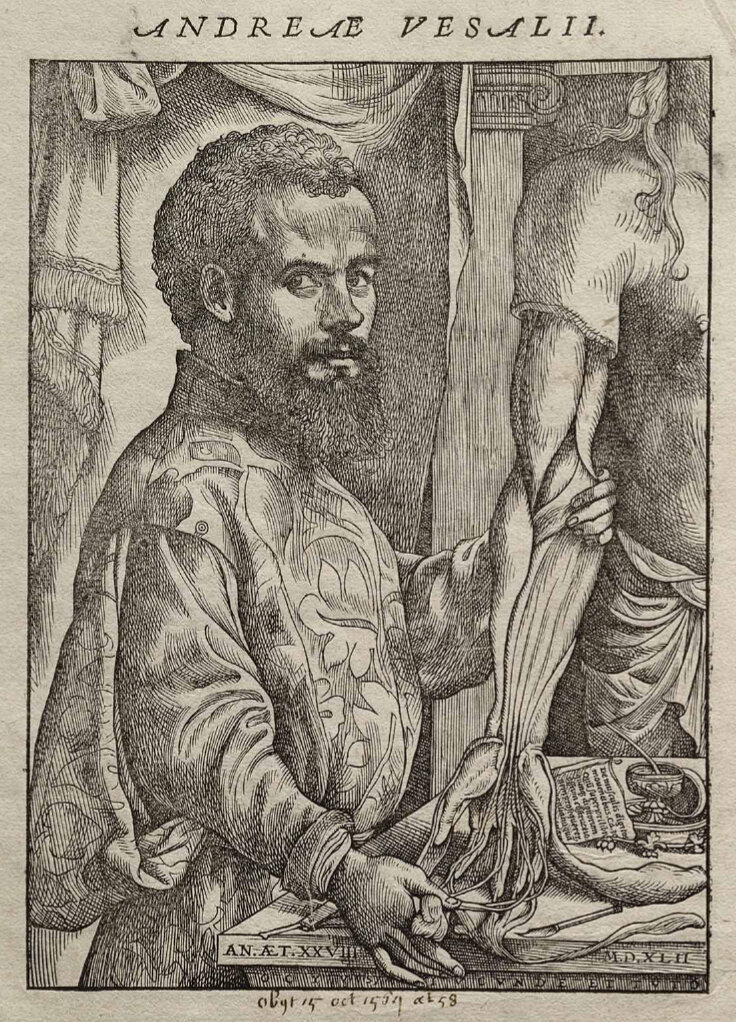Sympathy for the Necromancer

The next time your players say your grave-robbing necromancers are hard to believe, tell them to read about Andreas Vesalius.
The next time your players say your grave-robbing necromancers are hard to believe, tell them to read about Andreas Vesalius.
Andries van Wesel, better known by his Latinized name of Vesalius, was a physician and scientist credited as being one of the most important figures in the history of the study of anatomy. Vesalius lived in Europe in the 1500’s, at a time when European healers still held some very odd ideas about the human body. For most of the preceding millennium, the Catholic Church and other institutions of the era had dictated that it was forbidden to dissect human bodies, and as such, generations upon generations of physicians had been trained to know the inside of the human body primarily by reading books about it. This wouldn’t necessarily be a problem, except that the books in question were by and large written by Greek and Roman thinkers whose own studies of the bodies of animals and then extrapolated to humans, sometimes with hilarious errors as a result. These old texts were held in almost religious reverence, such that even when errors were found to be glaringly obvious, explanations and justifications were found for why this evidence could be dismissed. Early in his studies of medicine, Vesalius apparently became dissatisfied with what he perceived as major weaknesses in his teaching, and he developed, not merely an interest, but as the historian Frank Gonzales-Crussi put it, an obsession, with learning everything there was to know about human anatomy. To achieve this, Vesalius discovered that he would need something students (and even professors) were generally discouraged from having: direct contact with corpses.
The chief obstacle to Vesalius’ desire was a lack of bodies on which he could work. He was reported to hang around in cemeteries, examining the bones, and according to records he even robbed bodies out of graves under cover of night to bring them back to his lab. It’s believed that at times he kept rotting corpses in his bedroom, although it’s unclear to me from reading about this whether this was a way of observing the process of decomposition or whether he simply had nowhere else to put them. At the hospitals where he worked, Vesalius would instruct his students to take note of which patients were likely to die soon, the better to be ready to get access to the body as soon as possible. This isn’t to say that Vesalius resorted wholly to illegal and underhanded means. After he achieved a small measure of fame for a major book in his late twenties, he secured enough support from colleagues and royalty that he was given permission to dissect deceased criminals (according to some sources, possibly also living ones), and he made many of his dissections public such that they could be freely attended by students, artists, and really, pretty much anybody. At various points in his career, Vesalius was a member of one royal court or another and would travel with the court, which gave him opportunities to study combat wounds and the bodies of victims of war. Unfortunately for Vesalius, his work and his passions earned him enough enemies that he faced decades of mockery, even with princes and emperors as his patrons, and although this story is disputed by some historians, according to some books on his life, he was eventually forced to flee Europe and go to Jerusalem after the Inquisition ordered his death for unholy acts conducted in the name of science. Either way, Vesalius died following a shipwreck around the age of 50, and over the course of centuries he came to be recognized as one of the most important contributors to modern medicine.
What makes Vesalius interesting to us as gamers is that, in so many ways, his life parallels the cliché of the obsessional necromancer, who turns to defiling bodies in the name of research meant to advance the greater good. His obsession with anatomy and the acts that it led to came from, as far as we know, as earnest desire to advance knowledge and improve his ability to heal the sick, and if there was some other more grandiose or psychopathic motivation then it has been lost to history. It’s easy to imagine many a young spellcaster beginning with similarly noble motivations and, in a world where such things are an option, turning to necromancy as the ultimate way to study the body’s construction. Such a character could easily become as divisive and controversial a figure as Vesalius was, with some embracing his contributions to knowledge while other condemn his unholy methods. Numerous factors might then inform whether such a character remains noble and wise, or succumbs to temptation and the call of ever darker magic as a tool of study.
More than four years ago, Dr. Eris Lis, M.D., began writing a series of brilliant and informative posts on RPGs through the eyes of a medical professional, and this is the one that appeared here on May 1, 2016. Lis is a physician, gamer, and author of the Skirmisher Publishing LLC OGL sourcebook Insults & Injuries, which is also available for the Pathfinder RPG system.

